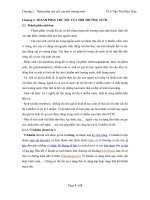Tài liệu Chương 2 Phân mạng vệ tinh di động hàng không AMSS doc
Bạn đang xem bản rút gọn của tài liệu. Xem và tải ngay bản đầy đủ của tài liệu tại đây (1.29 MB, 30 trang )
Trường Đại học Bách Khoa Hà Nội
Hanoi University of Science and Technology
© HUST 2012
Hệ thông Thông tin Hàng Không
TS. Đỗ Trọng Tuấn
Bộ môn Kỹ thuật thông tin
2
Trường Đại học Bách Khoa Hà Nội
Hanoi University of Science and Technology
Phân mạng vệ tinh di động hàng không AMSS
Chương 2
© HUST 2012
Hệ thống Thông tin Hàng Không
Teminologies
4
AMSS: Aeronautical Mobile Satellite Subsystem
AMS(R)S: Aeronautical Mobile-Satellite (Route) Service
BGAN: Broadband Global Area Network
Overview of ATN architecture
5
Introduction
6
Satellite system for aeronautical communications architecture as considered in
(ICAO, 2010)
AES (aircraft on board terminal)
GES (Earth terminal)
“transparent”
an IP router
AMS(R)S
The AMS(R)S provides voice and data
connectivity to users such as air traffic
controllers, pilots and aircraft operators
The AMSS comprises satellites, aeronautical
earth stations (AESs), ground earth stations
(GESs) and associated ground facilities such as
a network coordination center.
7
Existing satellite systems in operation for
aeronautical communications
Inmatsat, MTSAT
Iridium
AMS(R)S
8
Frequency bands allocated by the ITU.
The L band is defined as the Mobile Satellite Service
allocation in the frequency ranges 1525-1559 MHz and
1626.5-1660.5 MHz.
AMS(R)S
9
The principle of transmission in the safety satellite system
The mobile link, between the satellite and the aircraft, is built
on a safety satellite spectrum allocation, based on AMS(R)S
standard;
AMS(R)S
10
The principle of transmission in the safety satellite system
The satellite is in charge of signals frequency conversion,
simultaneously from C or Ku band to L band for the forward
link, and from L band to C or Ku band for the return link;
AMS(R)S
11
The principle of transmission in the safety satellite system
The fixed link, between the ground and the satellite, is built
on a fixed satellite spectrum allocation, based on FSS standard
AES
GES
Data/PSTN
AMS(R)S
AMS(R)S
Ku/Ka
-
band
Ku/Ka
- band L - band
Aeronautical
Gateway
ATN
Geostationary Satellite Systems
Civil aviation mainly uses satellite services from
geostationary satellites
14
Low-Earth Orbit Satellite Systems
Operate between 600 and 2000 km above the earth’s surface
Round trip delay of between 4 and 70 ms
15
LEO constallation
(16 satellites for round the world coverage)
Medium-Earth Orbit Satellite System
Operate between 3000 and 30 000 km above the earth’s
surface
Round trip delay of typically between 20 and 250 ms
No service providers are known to provide a general service
to the aeronautical civil application
16
Inmarsat
17
Inmarsat mobile system components
* Round trip propagation delay of between 240 and 280 ms
Inmarsat
18
illustrate postion of Inmarsat Satellites on the map?
Inmarsat Satellite and Ground Stations
E.g. Goonhilly in the UK, Eik in Norway and Aussaguel in France – all
acting as ground station (or hubbing points) for the Inmarsat aero service
to the Inmarsat 3-F2 satellite at 15.5◦ west
Inmarsat
Atlantic West
France Telecom
Telenor USA
Stratos UK
Atlantic East
France Telecom
Telenor Norway
Stratos UK
Indian Ocean
XANTIC Australia
Telenor Norway
Singapore Telecom
KDDI Japan
Pacific Ocean
XANTIC Australia
Telenor USA
Singapore Telecom
KDDI Japan
SITA
These ground stations are all single units with antennae linking to two satellites, except for the
Telenor USA stations that are separate units on the east and west coasts of the USA.
Skyphone
Inmarsat
AMS(R)S
21
Inmarsat satellite services have multiple allocations in L band (mainly
around 1.4 GHz) for the mobile portion, C Band (3.4–4.8 GHz), Ku (10.7–
12.75 GHz) and Ka (19–22 GHz) bands mainly for the fixed portion
Examples
22
Ex1. Link Budget Calculation
Satellite Theory
23
Satellite theory block diagram
Link Budget Equation
24
miles/km=1,609
Link Budget Equation
25
miles/km=1,852
C/No = ?









